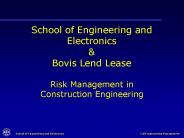Financial Engineering
1 / 24
Title:
Financial Engineering
Description:
Create structured securities from basic assets to catch specific market niches ... Convertible bond, Callable bond, Index bond, Floater. CMO, IO, PO ... – PowerPoint PPT presentation
Number of Views:188
Avg rating:3.0/5.0
Title: Financial Engineering
1
Financial Engineering
- Tyler Yang
- for
- Asian Real Estate Society
- July 4, 2002
2
Financial Engineering
- Trading Perspective
- Create structured securities from basic assets to
catch specific market niches - Modeling Perspective
- Develop/apply contingent claim valuation methods
to price exotic structured securities - Management Perspective
- Assess the uncertainty of future payoff of
portfolio - Determine strategies to restructure the portfolio
risk-return to meet investors objectives
3
Trading Perspective
- Design structured security to satisfy market
demand - Examples
- Futures Option, Swaption, Spread Option
- Convertible bond, Callable bond, Index bond,
Floater - CMO, IO, PO
- CDO, Credit swap, Credit linked bond
- ABS, Lease, Real option
4
Types of Cash Flows
5
Cash Flow Structure
- Un-guaranteed MBS
- CF1 Collected Interest Amortized Principal
Prepaid Principal Default Recovery - Guaranteed MBS
- CF2 CF1 Default Principal Default Recovery
Uncollected Interest - IO Strip (Servicing Right)
- CF3 Collected Interest ( Uncollected Interest)
6
Cash Flow Structure continued
- PO Strip
- CF4 Amortized Principal Prepaid Principal
Default Recovery (or Default Principal) - Servicing Right
- CF5 Servicing Fee Servicing Expense
- Guarantee Contract
- CF6 Guarantee Fee Default Principal
Recovery - Expense
7
Valuation
- Expected Cash Flows discounted at risk-adjusted
return (assume to be 7.25) - Value of Uninsured MBS 99.28
- Value of IO Value of PO
- Value of Insured MBS 100.00
8
Modeling Perspective
- Cash flow allocation
- Discounted cash flows
- Discount expected cash flows by a Risk-Adjusted
Return - Discount risk-adjusted cash flows by risk-free
9
Equilibrium (Risk-adjusted Return) Approach
- CAPM
- APT/Multi-factor CAPM
10
Cash Flow Projection
- Actuarial based distribution of outcomes
11
Equilibrium Approach
- Stock value can up to 200 with 70 probability
and down to 50 with 30 probability when
risk-free rate is 10 - Expected payoff .7 (200) .3 (50) 155
- u 200/100 2
- d 50/100 0.5
- r 1.10
- Risk-adjusted return 155/100 - 1 55
- Risk premium 55 - 10 45
12
Equilibrium Approach
- A call option with exercise price 125
- Possible payoffs are 80 with 70 probability and
0 with 30 probability - Expected payoff of option .7 (80) .3 (0)
56 - Beta of the option b(C) 1.83
- Risk-adjusted return k(C) 10 1.83 (45)
92.5 - Option Value C 56/(1.925) 29.09
13
Risk-Neutral Probability
14
Risk-Neutral Approach
- Risk-adjusted probability
- Pseudo probabilities
- Discount risk-adjusted expected cash flows at
risk-free rate
15
Risk-Neutral Approach
- Risk-neutral probability (u)
0.4 - Risk-neutral expected payoff of stock
- .4 (200) .6 (50) 110
- Stock price 110/1.10 100
- Risk-neutral expected payoff of the call option
.4 (80) .6 (0) 32 - Option value 32/1.10 29.09
16
Model Solutions
- Closed form solutions
- Black-Scholes model, Vasicek model
- Finite Difference Methods
- Implicit
- Explicit (trinomial tree)
- Binomial tree
- Monte Carlo Simulation
- Risk-neutral process
- Actuarial based process
17
Examples
- Lattice Method (Binomial Tree)
- American Put Option
- Monte Carlo Simulation
- Bond pricing under the Hull-White term structure
model - Value-at-Risk by Bootstrapping
18
Closed Form Solutions
- Pros
- Fast
- Easy to implement
- Cons
- Can only work under limited simplified
assumptions, which may not satisfy trading needs - May not exist for all derivative contracts
19
Finite Difference Methods
- Pros
- Intuitively simple
- Fast
- Capture forward looking behavior, best for
American style contracts - Accuracy increases with density of time interval
- Cons
- Can not price path-dependent contracts
- Difficult to implement, especially with time and
state dependent processes
20
Monte Carlo Simulations
- Pros
- Intuitive
- Easy to implement
- Matches VaR concept
- Accuracy increases with number of simulations
- Cons
- Forwardly simulate cash flows, cannot handle
American style contracts - Slow in convergence
21
Combined Approaches
- To handle both path-dependent and American style
cash flows - Difficult to implement and time consuming
- Alternative methods
- Simulation through tree
- Bundled simulation
22
Management Perspective
- Fundamental driving force of financial
engineering - Analyze the risk and return tradeoff for
different cash flow components of an
asset/portfolio - Determine the optimal risk-return profile for the
portfolio based on investors objectives and
constraints - To hedge or not to hedge?
- Value-at-Risk applications
- Capital adequacy requirements for regulator,
rating agency, stock holders
23
Example Striping MBS
24
Expand Research Scope
- Mathematical and technical advancements
- Volatility and hedging analysis
- Financial risk management applications
- Creative structure development
- General equilibrium impacts
- Policy implications































